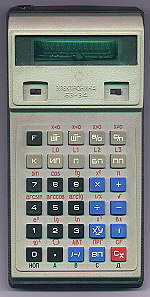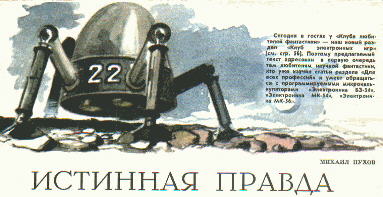|
Elektronika B3-34Soviet Calculator - Riddle |
|
|
By Sergei Frolov. Thanks to Kenton Green for help with correction English grammar of this page. This story is also suitable for following calculators: B3-34, B3-54, MK-52, MK-54, MK-56, MK-61. To Soviet users, it is likely well-known how to calculate on this calculator. Nevertheless, soon there will come a time when this calculalator will only be seen in calculator museums or with collectors. If you do not know how to calculate on this calculator, visit page "How to calculate on B3-34". Everything that you find on this page refers to the B3-34. All the material also applies to the similar models MK-54 and MK-56, and with some restrictions, to MK-61 and MK-52. I want first to bring it to your attention that in the final models, there
were some changes in the indicator [display]. Initially, the display was 12 digits with 12
decimal places. The left-most digit was used to indicate negative numbers, and the
right-most three [for exponent?]. A similar display was used in the B3-35, B3-36 and
MK-66. However, somewhere after 1985 there were changes made in the display: the left-most
digit now contains only the "minus" sign segment, and the third digit from the
right does not have the bottom segments. The three top segments of this digit on the
B3-35, B3-36 and MK-66 indicate the presence of numbers in the memory registers.  Most of the material placed here is taken from magazines that were popular in the USSR, "Science and Life" (shown at right) and "Engineering for Youth) (at left). The material was [collected?] into a manual by M. Pukhov and Ju. Pukhachev. A huge thanks to them! Since 1983 ("Science and Life") and 1995 ("Engineering for Youth") articles about the calculator B3-34 were published.
Most remarkable is that to generate special effects on the calculator ("the ship on the bright side of the moon"), undocumented features were used:
On the indicator is seen:
If you then continue by entering:
Aren't these remarkable graphics on the display, whether true or not? Now enter this:
The number displayed has an interesting property: if you multiply it by a number smaller than one you get zero, and by any other number, you get that number! It is possible to get the letter
If you store this letter in register 0, and then use the command "index recall
memory 0" If you enter the command Furthermore, it is possible to apply these commands to them: Most likely, the developers of this calculator forgot to place microcode blocking operation after an error message had occured. By the way, different errors result in different internal conditions, even though they are displayed on the display the same. For example, the overflow error caused by squaring a number larger than 1e50 differs from a 'divide by zero' error. The first error can be stored in a memory register, while the second cannot.
Continued on the next page. |
||

 However,
in my opinion the enormous popularity of programmable calculators began in 1985, when
Mikhail Pukhov initially authored a fantastic story -- the game "The True
Truth", followed by a no-less interesting "Way to Earth". If someone is
willing to clean up my English translation of the stories, I will place them on a web
page.
However,
in my opinion the enormous popularity of programmable calculators began in 1985, when
Mikhail Pukhov initially authored a fantastic story -- the game "The True
Truth", followed by a no-less interesting "Way to Earth". If someone is
willing to clean up my English translation of the stories, I will place them on a web
page.